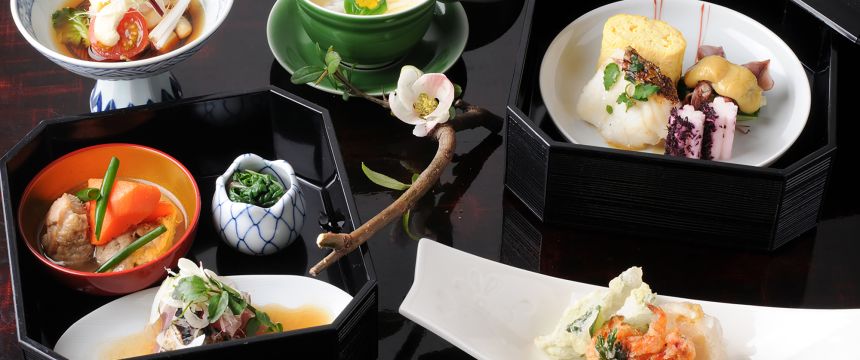Shimonita, Gunma Prefecture - Kanto

Head inland to Gunma Prefecture, and savor the many local specialties. Located in the heart of Honshu, the largest island in the Japanese archipelago, and blessed with fertile soil and a favorable climate, Gunma is well known across Japan for its bountiful—and tasty—produce.
Situated in the southwestern reaches of the prefecture is Shimonita. This rural town is famous for its Shimonita negi, a variety of bunching onions available for just three months each year. Characterized by their sweet taste and melt-in-your-mouth softness, Shimonita negi elevate the flavor of any dish to delicious new heights. The onions are particularly delightful, however, when added to another Gunma specialty, the hot pot of simmered meat and vegetables called sukiyaki.
Explore the Local Flavors at a Gastronomy-Focused Ryokan

Tokiwakan is a kappo ryokan, a type of traditional Japanese-style inn that prides itself on its cuisine—so you know you’re in for a treat when you go there! Drop by for lunch or make a reservation for dinner, and prepare to have your taste buds tantalized by meals made with delicious local ingredients.

Shimonita negi, the star of many a dish, is only available from mid-November to mid-February, so plan your trip accordingly. In fact, to truly appreciate the onions, you’ll need to plan more than one trip. As the cold of winter deepens, the onion’s sweetness changes, thereby altering the flavor of entire dishes.
At Tokiwakan, you’ll find Shimonita negi taking center stage in a special sukiyaki course that’s been offered since 2013.

In sukiyaki, ingredients such as negi, mushrooms, shirataki (konnyaku noodles), tofu, and meat are simmered in stock that thickens as it boils down. At Tokiwakan, the sequence in which the ingredients are added is paramount, and the cooking process is more grilling than simmering to maximize the incredible aroma that comes from the combination of these ingredients.

First to enter the hot pan is the Shimonita negi, which immediately emits a sweet aroma that fills the room. Although it is said that these onions are three times spicier than other onions and are rarely eaten raw, when the onions are heated through, the spiciness disappears and is replaced by a syrupy sweetness.

At Tokiwakan, only the best will do, so the next ingredient added is thinly sliced, top-quality Joshin wagyu beef, which is simmered to perfection in the establishment’s secret sukiyaki thick stock. At this point, it’s time to take a bite of beef and Shimonita negi, which after being dipped in a beaten raw egg—from locally raised hens, of course—is mouthwateringly delicious.

Other local ingredients continue to be added to the hot pan, bringing new flavors and textures to the meal. Truly, Tokiwakan’s sukiyaki with Shimonita negi is a feast to be savored slowly, one bite at a time—an incredible meal at an inn that more than deserves its designation as a kappo ryokan.
Give a Resounding “Oui!” to Sukiyaki with a French Twist

Sukiyaki stock comes in many variations, but it rarely—if ever—includes red wine. That is, until the French-trained fourth-generation owner of Yasubei, a long-established eatery popular with the locals for its comfortable atmosphere and unique fusion menu, decided to shake things up.

The result, a French-style tomato and wine sukiyaki, is a much lighter dish made with Shimonita negi, mugikaze chicken, shirataki (konnyaku noodles), shiitake, cherry tomatoes, edible chrysanthemums, and a variety of other local ingredients. Depending on the season, a variety of vegetables such as pumpkin, black radishes, turnips, and bell peppers also make an appearance.

Inspired by coq au vin, which pairs chicken with red wine, Yasubei’s owner-chef adds shoyu (soy sauce), sugar, and cassis to the stock, giving a truly unique twist to a traditional Japanese dish. All ingredients are gently simmered together. When steam rises from the surface, it’s time to dig in.

The firm meat of the chicken goes well with the soft texture of the Shimonita negi, whose sweet taste is enhanced by the subtle sweetness of the wine. It is truly a flavor you won’t find elsewhere, and it is proof that when food cultures come together, good things happen.

Discover the Joys of Japan’s Michi-no-Eki Markets

No road trip in Japan is complete without a stop at a michi-no-eki, or roadside rest area. But it’s not just a place for snacks, gas, and restrooms. Japan’s michi-no-eki often have a market, where you can pick up souvenirs of local delicacies, fresh vegetables and fruit, and other goods. Indeed, the majority of the vegetables used at Yasubei are procured at the local michi-no-eki.
At Michi-no-Eki Shimonita, you’ll find all sorts of locally cultivated products and, between December and the end of February, row after row of Shimonita negi.

It might seem strange that the onion has such a short season, but there is a good reason for that, according to the stationmaster of Michi-no-Eki Shimonita: the Shimonita negi takes an astonishing fifteen months to cultivate, from sowing to harvesting. On top of that, the onions are sensitive to temperature and other weather conditions. Because of their fragility, for a long time Shimonita negi could be grown only in this area and were so valuable that they were nicknamed tonosama negi (nobleman’s bunching onion).

Nowadays, Shimonita negi can be cultivated elsewhere, and the variety has been established as the Shimonita cultivar. But of course, the onion’s sensitivity to temperature means that only the Shimonita negi grown in Shimonita have the original Shimonita-negi flavor.

Before heading on, stop for a quick snack of deep-fried Shimonita-negi age at Marumoya, located in the dining area. Coated in panko before being tossed into the hot oil, the finished snack is crispy on the outside and fluffy on the inside. Season it with salt and pepper to bring out the sweetness.

On your way out, stop to admire the neighboring field. Yes, those green leaves poking out of the ground are Shimonita negi, like the ones you enjoyed during your stay—and these will only become sweeter as the temperature drops.
Once your Gunma journey is at an end you are sure to find that the very thought of sukiyaki, perfectly complemented by the Shimonita negi, is sure to call you back time and time again.
Contact Information
Tokiwakan
359-2 Shimonita, Shimonita-machi, Kanra District, Gunma Prefecture 370-2601
Yasubei
363-6 Shimonita, Shimonita-machi, Kanra District, Gunma Prefecture 370-2601
Michi-no-Eki Shimonita
3766-11 Miyama, Shimonita-machi, Kanra District, Gunma Prefecture 370-2603
How to Get There
Shimonita is a rural town located in southwestern Gunma. It can be accessed by train from Ueno Station in Tokyo. Board the Akagi Limited Express Kusatsu, and transfer at Takasaki Station to the Joshin Dentetsu local train heading for Shimonita. It takes approximately two hours and thirty minutes to reach Shimonita by train.
Shimonita is located along National Road 254, approximately five minutes from the Shimonita Interchange on the Joshin-Etsu Expressway.
Recommended Itineraries
Prepare for adventure when you travel to Shimonita. The town is surrounded by nature and is home to the Shimonita Geopark, where you can discover the secrets behind the area’s strange geological formations. Enjoy a soak in a hot spring by heading west to Arafune-no-Yu, a day-use facility accessible by train. Other activities are also available, including a konnyaku-making workshop. Take note that Shimonita covers a vast expanse of land, and getting from one destination to the next may require a hop on the train or a ride in a car or taxi.
Related Links
Shimonita Town Tourism Association (English)
Michi-no-Eki Shimonita (Japanese)
Gunma (English)
Map
Featured Cuisine
Sukiyaki is a traditional hot-pot dish of thinly sliced meat and vegetables simmered in a shallow pan with sukiyaki stock. Commonly used ingredients include mushrooms; sliced bunching onions, such as the soft, syrupy Shimonita negi; shirataki (konnyaku noodles); tofu; shungiku (chrysanthemum greens); and beef. Winter nights will find many a home with windows fogged from steam rising out of the sukiyaki pan as its contents simmer away on the dining-room table.
-
Author
Author: Helen
Helen hails from a small town in Central Canada. Shortly after completing an honors degree in history, a desire to study karate in its birthplace drew her to Japan. Since arriving in 2006, she has earned her second dan in Goju-ryu karate, fallen head-first into Japanese culture by way of cross-cultural marriage, and written about Japan for a variety of publications. She loves traveling by Shinkansen, curling up under a heated kotatsu blanket, and eating anything with mochi.
All information is correct as of the time of writing.
Please check for the latest information before you travel.






























































